![]()
Introduction to our new series - what you need, who is it aimed at?
Welcome to the second in this bi-monthly series which encourages you to explore in close-up the everyday things around your home, garden and garage which we all take for granted.
This month the author completes a close-up look at electronics around the home. Please read the footnote and disclaimer.
A Quartz Watch -
why is it so accurate?
![]()
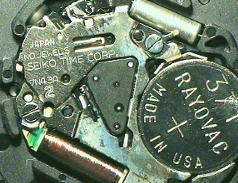 A very cheap quartz watch is probably as accurate if
not more accurate than a watch with an expensive traditional
mechanical movement. Why?
A very cheap quartz watch is probably as accurate if
not more accurate than a watch with an expensive traditional
mechanical movement. Why?
If you have one of the cheapest quartz watches you don't mind taking the back off (and possibly damaging!), it's interesting to look at the mechanism. The inside of a quartz watch is shown right (magnified 5x, battery diameter is 9.5mm). Much of the mechanism is dominated by the battery, and there is little evidence of the 'movement' seen in mechanical watches. The 'heart' of a quartz watch is the metallic cylinder on the top right. This houses the quartz crystal which is responsible for time-keeping. The brown cylinder at the bottom right is an electrical coil which forms part of the electronic circuit.
The clue to why a quartz watch keeps very good time (and why atomic clocks keep even better time) is related to the frequency at which a quartz crystal (or atom for an atomic clock) vibrates. Click here to read how the quartz watch keeps time.
Video camera chip
![]()
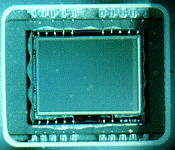 Most domestic video camera / recorders (camcorders) do
not have a removable lens, therefore it is difficult to see the
CCD chip on which the image is projected and converted into
electrical signals for recording. The author possesses a security
type video camera used for microscopy without a lens, which
allowed me to have a closer look at the CCD chip which is shown
right.
Most domestic video camera / recorders (camcorders) do
not have a removable lens, therefore it is difficult to see the
CCD chip on which the image is projected and converted into
electrical signals for recording. The author possesses a security
type video camera used for microscopy without a lens, which
allowed me to have a closer look at the CCD chip which is shown
right.
The area of the chip which is sensitive to light (the inner rectangle to which wires are attached) is 6.4x4.8mm across and is comprised of an array of 681x582 discrete pixels. In comparison the Hubble Space telescope has four CCD chips mosaicked together giving a pixel array of 1600x1600 pixels. Click here to learn a bit more about how a CCD chip works.
The CCD chip, or charge coupled device is a marvel of modern electronic miniaturisation. Not only has it brought video filming and recording to you and me at a modest price, but it has had a profound influence on the way modern astronomy is carried out. The CCD chip is a 100 times more sensitive than a photographic plate and the detector can also be altered to provide sensitivity at wavelengths outside the visible spectrum but of importance in astronomy.
Electronic
components - the quest for miniaturisation
![]()
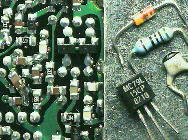 Most of us are probably familiar with the incredible
progress made in increasing the number of components on a
computer chip. The Pentium Pro processor for example, found in
the latest PC's has over 5 million transistors on a single chip.
However, less impressive but steady progress has also been made
in the construction of components like transistors, resistors and
capacitors that are still required as discrete components
on many circuit boards where space is at a premium.
Most of us are probably familiar with the incredible
progress made in increasing the number of components on a
computer chip. The Pentium Pro processor for example, found in
the latest PC's has over 5 million transistors on a single chip.
However, less impressive but steady progress has also been made
in the construction of components like transistors, resistors and
capacitors that are still required as discrete components
on many circuit boards where space is at a premium.
The large discrete components shown on the right of the image above are still used in many larger domestic items where space saving is not essential. These components are from top to bottom a diode, resistor, capacitor and transistor and are magnified about 2.5X. Note that they each have thick wires which need to be inserted into holes in the circuit board before soldering.
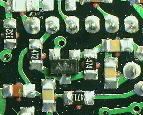 Compare these
components with those shown on the left of the image at the same
magnification, and shown at a higher magnification on the left.
Each of the tiny black, yellow and brown rectangles (typically 3
x 1.5mm in size) is still a discrete component, but they are surface
mount components. Each component has no wires, they are
soldered onto the surface of the circuit board using the tiny
solderable ends. This allows a much higher density of components
to be fitted on a circuit board, and they are now widely used in
consumer items where miniaturisation of components is essential
to keep the item compact eg portable phones, and lap top
computers.
Compare these
components with those shown on the left of the image at the same
magnification, and shown at a higher magnification on the left.
Each of the tiny black, yellow and brown rectangles (typically 3
x 1.5mm in size) is still a discrete component, but they are surface
mount components. Each component has no wires, they are
soldered onto the surface of the circuit board using the tiny
solderable ends. This allows a much higher density of components
to be fitted on a circuit board, and they are now widely used in
consumer items where miniaturisation of components is essential
to keep the item compact eg portable phones, and lap top
computers.
I'm not suggesting you take electrical
equipment apart to inspect the components, but if you or a
colleague are upgrading your desktop PC which are designed to be
user upgradable, you could take a look at the components on the
boards. For example, I noticed that the surface mount components
shown above were used extensively on a circuit board which was
part of an old hard disc drive that I'd replaced in my PC.
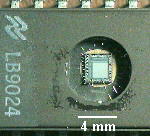 You can often buy
interesting bits of electronic circuits for a few pence at junk
shops selling 'old' computer or electrical equipment. One thing
that is worth looking out for is a chip that has a transparent
plastic disc in the top, see image left. This is an EPROM chip
and the larger circuit details can be seen quite clearly using a
10X hand lens or low power stereo microscope.
You can often buy
interesting bits of electronic circuits for a few pence at junk
shops selling 'old' computer or electrical equipment. One thing
that is worth looking out for is a chip that has a transparent
plastic disc in the top, see image left. This is an EPROM chip
and the larger circuit details can be seen quite clearly using a
10X hand lens or low power stereo microscope.
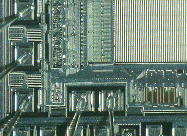 EPROM stands for
erasable programmable read only memory. In an EPROM chip the
information stored on the rectangular array of memory shown is
usually erased by exposure to ultra violet light, and can be
reprogrammed using the correct equipment. EPROM chips are often
used in equipment where the information needs to be regularly
upgraded such as the BIOS (basic input / output system) which
contains fundamental operating instructions.
EPROM stands for
erasable programmable read only memory. In an EPROM chip the
information stored on the rectangular array of memory shown is
usually erased by exposure to ultra violet light, and can be
reprogrammed using the correct equipment. EPROM chips are often
used in equipment where the information needs to be regularly
upgraded such as the BIOS (basic input / output system) which
contains fundamental operating instructions.
The close-up of the chip on the right above shows the wires connecting the pins of the chip to the circuit and the main erasable memory on the top right of the image.
Portable PC screens -
liquid crystal displays
![]()
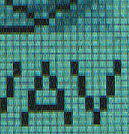 In the
first of the Home
In Close Up series we had a look at TV
screens and PC monitor screens. To complete the picture, I had a
look at my brother's display screen on his notebook computer. It
is a modest specification and only possesses a 64 grey scale
backlit LCD screen. The screen magnified about 12X is shown on
the right and shows how the vertical and diagonal components of
the text are built up, as well as the different levels of grey
used to build up the picture above the text. The individual
pixels can be seen by eye or more easily with a 10X lens on a
laptop computer if you have access to one. Each pixel, the tiny
blocks shown in the image, are about 0.25mm square.
In the
first of the Home
In Close Up series we had a look at TV
screens and PC monitor screens. To complete the picture, I had a
look at my brother's display screen on his notebook computer. It
is a modest specification and only possesses a 64 grey scale
backlit LCD screen. The screen magnified about 12X is shown on
the right and shows how the vertical and diagonal components of
the text are built up, as well as the different levels of grey
used to build up the picture above the text. The individual
pixels can be seen by eye or more easily with a 10X lens on a
laptop computer if you have access to one. Each pixel, the tiny
blocks shown in the image, are about 0.25mm square.
LCD screens are now found in many consumer goods around the home. The individual pixels are often a lot larger than those on a PC, in for example displays on clocks, watches, hi-fi or video tape recorder where simple alphanumeric information easily read from a distance needs to be displayed.
You may have guessed by now that the author is fascinated by developments in electronics around the home. If you had no previous interest in this particular aspect of the 'home in close-up' I hope I've passed on some of my enthusiasm. Next month we will look at more familiar objects around the home.
What do you
need? - each subject covered in this series will have an
icon to show what you will need to study an object.
![]() can be viewed with
a 10X hand lens or similar magnifying glass.
can be viewed with
a 10X hand lens or similar magnifying glass.
![]() use a low power stereo
microscope 10X-40X for a clearer look
use a low power stereo
microscope 10X-40X for a clearer look
![]() requires a compound microscope with magnifications 30X
up to 200X
requires a compound microscope with magnifications 30X
up to 200X
Who is the series designed for? We've tried to make it of interest to both the novice and more experienced microscopist. Each topic will have a brief description with images to illustrate the fascinating things you can find to look at. But there will be a click here prompt for many topics which will provide more background information and suggestions for further study.
Important
footnote - mainly for younger readers
The author is not encouraging you to dismantle electrical or
other equipment in this series as it is potentially dangerous and
could also damage the equipment. But if something is being
repaired or being taken apart by experienced people why not ask
if it is safe to take a closer look and also ask how it works.
Disclaimer: all the information in this series is given in good faith. However, no responsibility is accepted for damage to property or injury to persons as a result of readers investigating the subjects described. It is up to the reader to judge whether the subjects can be safely viewed in their own home. Younger readers should consult their parents or teacher as appropriate before examining either their own or somebody else's property. Return to top of page